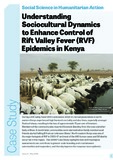Understanding Sociocultural Dynamics to Enhance control of Rift Valley Fever (RVF) Epidemics in Kenya
Comprendre la dynamique socioculturelle pour mieux contrôler les épidémies de fièvre de la Vallée du Rift (FVR) au Kenya
Date
2020-06-16Author
Bukachi, Salome
Mburu, Caroline
Bett, Bernard
Metadata
Show full item recordImpact
Abstract
During a Rift Valley Fever (RVF) outbreak in 2006–07, Somali pastoralists in northeastern Kenya experienced high livestock mortality and abortions, especially amongst flocks of sheep, resulting in the loss of approximately 75 per cent of livestock. Members of the community also reported livestock bleeding from the nose and other body orifices. A month later, communities were alarmed when family members and friends started falling ill from an ‘unknown illness’.
North-eastern Kenya was one of the major hotspots of RVF in 2006–07 and most of the 400 human cases and 90 deaths occurred in this region. This SSHAP Case Study highlights how anthropological assessments can contribute to greater understanding and trust between communities and responders, and thereby improve the response to an epidemic. Lors d’une flambée épidémique de fièvre de la Vallée du Rift (FVR) survenue en 2006–07,
les bergers somaliens dans le nord-est du Kenya ont subi des taux de mortalité et
d’avortements élevés, notamment parmi les troupeaux de moutons, ce qui a engendré la
perte d’environ 75 pour cent du cheptel. Les membres de la communauté ont également signalé des saignements du bétail par le
nez et d’autres orifices corporels. Un mois plus tard, les communautés se sont inquiétées
lorsque des proches et des amis ont commencé à tomber malade à cause d’une « maladie
inconnue ». Le nord-est du Kenya a constitué l’un des principaux foyers de FVR en 2006–07
et la plupart des 400 cas humains et les 90 décès sont survenus dans cette région. Cette
étude de cas SSHAP met en évidence la manière dont les études anthropologiques peuvent
contribuer à renforcer la compréhension et la confiance entre les communautés et les
intervenants, et ainsi améliorer la riposte contre une épidémie.
Citation
Bukachi, S.A.; Mburu, C.M. and Bett, B.K. (2020) Understanding Sociocultural Dynamics to Enhance Control of Rift Valley Fever (RVF) Epidemics in Kenya, SSHAP Case Study Issue 11, UNICEF, IDS and Anthrologica.Bukachi, S.A.; Mburu, C.M. and Bett, B.K. (2020) Comprendre la dynamique socioculturelle pour mieux contrôler les épidémies de fièvre de la Vallée du Rift (FVR) au Kenya, Étude de cas SSHAP Numéro 11, UNICEF, IDS et Anthrologica
Is part of series
SSHAP Case Studies;Issue 11More details
https://www.socialscienceinaction.org/Rights holder
SSHAPRights details
http://creativecommons.org/licenses/by/4.0/Sponsor
UNICEFUSAID


